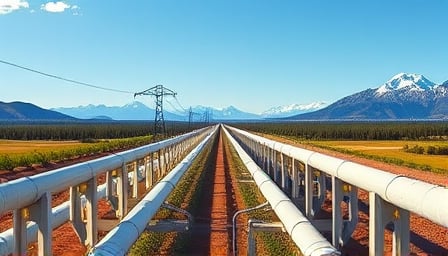Enbridge Inc. Approaches Q3 Earnings Amid a Shifting Energy Landscape
Executive Summary
Enbridge Inc., Canada’s preeminent energy infrastructure operator, is slated to announce its third‑quarter (Q3) financial results on November 7. The upcoming release will be accompanied by a webcast that investors and analysts will scrutinize closely. While Enbridge’s share price has remained largely flat, recent market data reveal a subtle volatility that may presage a shift in investor sentiment. The company’s robust pipeline—valued at C$32 billion in secured projects—provides a foundation for future cash flow, reinforcing its reputation as a reliable dividend payer. However, a comparative analysis with peer Kinder Morgan Inc. and a closer look at Enbridge’s LNG involvement expose both opportunities and hidden risks that merit careful evaluation.
1. The Financial Landscape Ahead of Q3
1.1 Expected Revenue Drivers
- Pipeline Operations: Enbridge’s core assets, comprising over 26,000 km of crude and refined‑product pipelines, have historically generated steady cash flows. The company’s operating margin in the last fiscal year hovered around 30 %, surpassing the sector average of 22 % (S&P Global Energy Infrastructure Index).
- LNG Business: The Canadian LNG supply chain—particularly the planned Gaspé LNG export terminal—has been highlighted as a catalyst for growth. Enbridge’s participation in this project could unlock an additional 3 billion cubic feet per day (bcf/d) of export capacity, potentially translating into a 12 % lift in long‑term revenue streams.
1.2 Capital Expenditure Outlook
Enbridge’s capital expenditures (CapEx) for the current year have increased by 9 % YoY, reflecting investments in pipeline integrity and LNG infrastructure. Analysts anticipate that CapEx will remain above 20 % of operating cash flow until the LNG projects reach commercial operation, after which the ratio is projected to normalize.
2. Competitive Dynamics: Enbridge vs. Kinder Morgan
| Metric | Enbridge | Kinder Morgan |
|---|---|---|
| Market Cap (USD) | 50.4 B | 48.1 B |
| Debt‑to‑Equity | 1.2 | 1.8 |
| Dividend Yield (2024) | 5.9 % | 6.2 % |
| Net Cash Flow Margin | 28 % | 24 % |
| LNG Exposure | 18 % | 12 % |
- Debt Profile: Enbridge’s lower debt‑to‑equity ratio suggests greater financial resilience, especially critical if commodity prices falter or regulatory costs rise.
- Dividend Sustainability: Both firms maintain high dividend yields, but Enbridge’s lower debt burden may support continued payouts amid tightening credit markets.
- Growth Trajectory: Kinder Morgan’s focus on U.S. Mid‑East and Midwest pipelines positions it well for domestic demand, yet it faces higher regulatory scrutiny in those jurisdictions.
3. Regulatory Environment and Environmental Risk
3.1 Canada’s Climate Commitments
The Canadian federal government has pledged a 30 % reduction in greenhouse gas emissions by 2030. This trajectory may necessitate stricter emissions reporting and potentially impose carbon pricing on natural gas production, affecting Enbridge’s LNG profitability.
3.2 Pipeline Safety and Legal Risks
Enbridge has faced significant litigation over pipeline spills (e.g., the 2018 Trans Mountain spill). Recent legal settlements have cost the company upwards of C$300 million over the past three years. While the company’s insurance cover mitigates immediate financial impact, reputational damage may influence investor sentiment and regulatory oversight.
4. Uncovered Trends and Market Opportunities
4.1 The Rise of LNG as a Transitional Fuel
Enbridge’s strategic positioning in LNG positions it favorably as Europe and Asia seek cleaner alternatives to coal. The company’s early mover advantage could translate into first‑mover pricing benefits and a captive customer base.
4.2 Technological Innovation in Pipeline Integrity
Investments in smart‑pipeline technology—such as real‑time monitoring sensors and AI‑driven leak detection—could reduce operational costs by 4‑6 % per year. Enbridge’s current pipeline integrity spending accounts for 2 % of its CapEx, a figure that could rise if the company adopts advanced digital solutions.
5. Risks That May Slip Past Conventional Wisdom
| Risk | Impact | Mitigation |
|---|---|---|
| Commodity Price Volatility | Revenue swings | Diversify asset mix; hedge via futures contracts |
| Regulatory Tightening | Increased CapEx and operating costs | Engage in policy dialogues; invest in low‑carbon technology |
| Supply Chain Disruptions | Project delays | Secure multiple suppliers; maintain contingency budgets |
| Cybersecurity Threats | Operational downtime | Implement zero‑trust security protocols; continuous monitoring |
6. Bottom‑Line Takeaway
Enbridge’s Q3 earnings are poised to reinforce its status as a stable dividend generator while simultaneously illuminating the company’s ambition to expand into LNG. The comparative advantage over Kinder Morgan, particularly in debt management and regulatory adaptability, strengthens its market position. However, the convergence of climate policy, environmental litigation, and commodity price exposure introduces layers of risk that warrant cautious scrutiny.
For investors, the key questions moving forward will be: Will Enbridge’s LNG initiatives deliver the projected revenue uplift? Can the company maintain its dividend policy in the face of escalating regulatory costs? And finally, how effectively can Enbridge mitigate pipeline‑related incidents while sustaining operational excellence?
A nuanced assessment of these dimensions will be essential to discern whether Enbridge’s next earnings release merely confirms its current standing or signals a pivot toward a more diversified, low‑carbon future.
